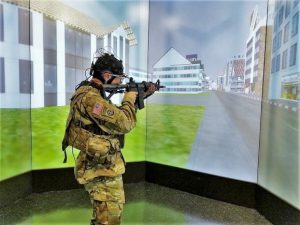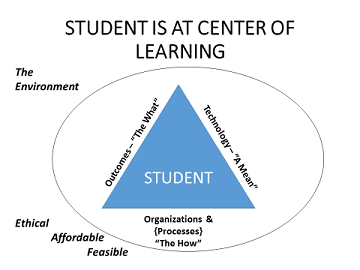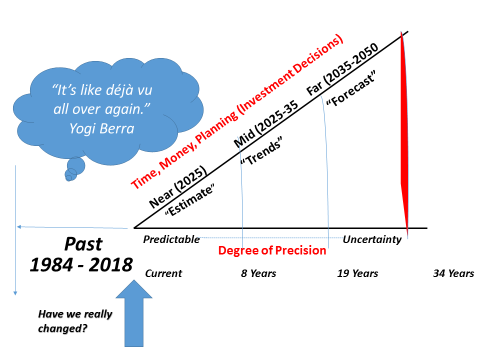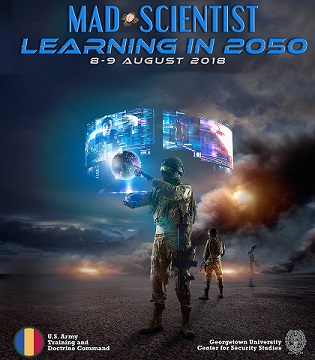[Editor’s Note: The U.S. Army Training and Doctrine Command (TRADOC) G-2 is co-hosting the Mad Scientist Learning in 2050 Conference with Georgetown University’s Center for Security Studies on 8-9 August 2018 in Washington, DC. In advance of this conference, Mad Scientist Laboratory is pleased to present today’s post addressing what is necessary to truly transform Learning in 2050 by returning guest blogger Mr. Nick Marsella. Read Mr. Marsella’s previous two posts addressing Futures Work at Part I and Part II]
Only a handful of years ago, a conference on the topic of learning in 2050 would spur discussions on needed changes in the way we formally educate and train people to live successful lives and be productive citizens.[I] Advocates in K-12 would probably argue for increasing investment in schools, better technology, and increased STEM education. Higher educators would raise many of the same concerns, pointing to the value of the “the academy” and its universities as integral to the nation’s economic, security, and social well-being by preparing the nation’s future leaders, innovators, and scientists.
Yet, times have changed. “Learning in 2050” could easily address how education and training must meet the required immediate learning needs of the individual and for supporting “lifelong learning” in a very changing and competitive world.[II] The conference could also address how new discoveries in learning and the cognitive sciences will inform the education and training fields, and potentially enhance individual abilities to learn and think.[III] “Learning in 2050” could also focus on how organizational learning will be even more important than today – spelling the difference between bankruptcy and irrelevancy – or for military forces – victory or defeat. We must also address how to teach people to learn and organize themselves for learning.[IV]
Lastly, a “Learning in 2050” conference could also focus on machine learning and how artificial intelligence will transform not only the workplace, but have a major impact on national security.[V] Aside from understanding the potential and limitations of this transformative technology, increasingly we must train and educate people on how to use it to their advantage and understand its limitations for effective “human – machine teaming.” We must also provide opportunities to use fielded new technologies and for individuals to learn when and how to trust it.[VI]
All of these areas would provide rich discussions and perhaps new insights. But just as LTG (ret) H.R. McMaster warned us about thinking about the challenges in future warfare, we must first acknowledge the continuities for this broad topic of “Learning in 2050” and its implications for the U.S. Army.[VII] Until the Army is replaced by robots or knowledge and skills are uploaded directly into the brain as shown in the “Matrix” — learning involves humans and the learning process and the Army’s Soldiers and its civilian workforce [not discounting organizational or machine learning].

While much may change in the way the individual will learn, we must recognize that the focus of “Learning in 2050” is on the learner and the systems, programs/schools, or technologies adopted in the future must support the learner. As Herbert Simon, one of the founders of cognitive science and a Nobel laureate noted: “Learning results from what the student does and thinks and only from what the student does and thinks. The teacher can advance learning only by influencing what the student does to learn.”[VIII] To the Army’s credit, the U.S. Army Learning Concept for Training and Education 2020-2040 vision supports this approach by immersing “Soldiers and Army civilians in a progressive, continuous, learner-centric, competency-based learning environment,” but the danger is we will be captured by technology, procedures, and discussions about the utility and need for “brick and mortar schools.”[IX]
Learning results from what the student does and thinks and only from what the student does and thinks.
Learning is a process that involves changing knowledge, belief, behavior, and attitudes and is entirely dependent on the learner as he/she interprets and responds to the learning experience – in and out of the classroom.[X] Our ideas, concepts, or recommendations to improve the future of learning in 2050 must either: improve student learning outcomes, improve student learning efficiency by accelerating learning, or improve the student’s motivation and engagement to learn.

“Learning in 2050” must identify external environmental factors which will affect what the student may need to learn to respond to the future, and also recognize that the generation of 2050 will be different from today’s student in values, beliefs, attitudes, and acceptance of technology.[XI] Changes in the learning system must be ethical, affordable, and feasible. To support effective student learning, learning outcomes must be clearly defined – whether a student is participating in a yearlong professional education program or a five-day field training exercise – and must be understood by the learner.[XII]
We must think big. For example, Professor of Cognition and Education at Harvard’s Graduate School of Education, Howard Gardner postulated that to be successful in the 21st Century requires the development of the “disciplined mind, the synthesizing mind, the creative mind, the respectful mind, and the ethical mind.”[XIII]
Approaches, processes, and organization, along with the use of technology and other cognitive science tools, must focus on the learning process. Illustrated below is the typical officer career timeline with formal educational opportunities sprinkled throughout the years.[XIV] While some form of formal education in “brick and mortar” schools will continue, one wonders if we will turn this model on its head – with more upfront education; shorter focused professional education; more blended programs combining resident/non-resident instruction; and continual access to experts, courses, and knowledge selected by the individual for “on demand” learning. Today, we often use education as a reward for performance (i.e., resident PME); in the future, education must be a “right of the Profession,” equally provided to all (to include Army civilians) – necessary for performance as a member of the profession of arms.

The role of the teacher will change. Instructors will become “learning coaches” to help the learner identify gaps and needs in meaningful and dynamic individual learning plans. Like the Army’s Master Fitness Trainer whom advises and monitors a unit’s physical readiness, we must create in our units “Master Learning Coaches,” not simply a training specialist who manages the schedule and records. One can imagine technology evolving to do some of this as the Alexa’s and Siri’s of today become the AI tutors and mentors of the future. We must also remember that any system or process for learning in 2050 must fit the needs of multiple communities: Active Army, Army National Guard, and Army Reserve forces, as well as Army civilians.
Just as the delivery of instruction will change, the assessment of learning will change as well. Simulations and gaming should aim to provide an “Enders’ Game” experience, where reality and simulation are indistinguishable. Training systems should enable individuals to practice repeatedly and as Vince Lombardi noted – “Practice does not make perfect. Perfect practice makes perfect.” Experiential learning will reinforce classroom, on-line instruction, or short intensive courses/seminars through the linkage of “classroom seat time” and “field time” at the Combat Training Centers, Warfighter, or other exercises or experiences.
Tell me and I forget; teach me and I may remember; involve me and I learn. Benjamin Franklin[XV]
Of course, much will have to change in terms of policies and the way we think about education, training, and learning. If one moves back in time the same number of years that we are looking to the future – it is the year 1984. How much has changed since then?

While in some ways technology has transformed the learning process – e.g., typewriters to laptops; card catalogues to instant on-line access to the world’s literature from anywhere; and classes at brick and mortar schools to Massive Open Online Courses (MOOCs), and blended and on-line learning with Blackboard. Yet, as Mark Twain reportedly noted – “if history doesn’t repeat itself – it rhymes” and some things look the same as they did in 1984, with lectures and passive learning in large lecture halls – just as PowerPoint lectures are ongoing today for some passively undergoing PME.
If “Learning in 2050” is to be truly transformative – we must think differently. We must move beyond the industrial age approach of mass education with its caste systems and allocation of seats. To be successful in the future, we must recognize that our efforts must center on the learner to provide immediate access to knowledge to learn in time to be of value.
Nick Marsella is a retired Army Colonel and is currently a Department of the Army civilian serving as the Devil’s Advocate/Red Team for Training and Doctrine Command. ___________________________________________________________________
[I] While the terms “education” and “training” are often used interchangeably, I will use the oft quoted rule – training is about skills in order to do a job or perform a task, while education is broader in terms of instilling general competencies and to deal with the unexpected.
[II] The noted futurist Alvin Toffler is often quoted noting: “The illiterate of the 21st Century are not those who cannot read and write but those who cannot learn, unlearn, and relearn.”
[III] Sheftick, G. (2018, May 18). Army researchers look to neurostimulation to enhance, accelerate Soldier’s abilities. Retrieved from: https://www.army.mil/article/206197/army_researchers_looking_to_neurostimulation_to_enhance_accelerate_soldiers_abilities
[IV] This will become increasing important as the useful shelf life of knowledge is shortening. See Zao-Sanders, M. (2017). A 2×2 matrix to help you prioritize the skills to learn right now. Harvard Business Review. Retrieved from: https://hbr.org/2017/09/a-2×2-matrix-to-help-you-prioritize-the-skills-to-learn-right-now — so much to learn, so little time.
[V] Much has been written on AI and its implications. One of the most recent and interesting papers was recently released by the Center for New American Security in June 2018. See: Scharre, P. & Horowitz, M.C. (2018). Artificial Intelligence: What every policymaker needs to know. Retrieved from: https://www.cnas.org/publications/reports/artificial-intelligence-what-every-policymaker-needs-to-know
For those wanting further details and potential insights see: Executive Office of the President, National Science and Technology Council, Committee on Technology Report, Preparing for the Future of Artificial Intelligence, October 2016.
[VI] Based on my anecdotal experiences, complicated systems, such as those found in command and control, have been fielded to units without sufficient training. Even when fielded with training, unless in combat, proficiency using the systems quickly lapses. See: Mission Command Digital Master Gunner, May 17, 2016, retrieved from https://www.army.mil/standto/archive_2016-05-17. See Freedberg, S. Jr. Artificial Stupidity: Fumbling the Handoff from AI to Human Control. Breaking Defense. Retrieved from: https://breakingdefense.com/2017/06/artificial-stupidity-fumbling-the-handoff/
[VII] McMaster, H.R. (LTG) (2015). Continuity and Change: The Army Operating Concept and Clear Thinking about Future War. Military Review.
[VIII] Ambrose, S.A., Bridges, M.W., DiPietro, M., Lovett, M.C. & Norman, M. K. (2010). How learning works: 7 research-based principles for smart teaching. San Francisco, CA: Jossey-Bass, p. 1.
[IX] U.S. Army Training and Doctrine Command. TRADOC Pamphlet 525-8-2. The U.S. Army Learning Concept for Training and Education 2020-2040.
[X] Ambrose, et al., p.3.
[XI] For example, should machine language be learned as a foreign language in lieu of a traditional foreign language (e.g., Spanish) – given the development of automated machine language translators (AKA = the Universal Translator)?
[XII] The point here is we must clearly understand what we want the learner to learn and adequately define it and insure the learner knows what the outcomes are. For example, we continually espouse that we want leaders to be critical thinkers, but I challenge the reader to find the definitive definition and expected attributes from being a critical thinker given ADRP 6-22, Army Leadership, FM 6-22 Army Leadership, and ADRP 5 and 6 describe it differently. At a recent higher education conference of leaders, administrators and selected faculty, one member succinctly put it this way to highlight the importance of student’s understanding expected learning outcomes: “Teaching students without providing them with learning outcomes is like giving a 500 piece puzzle without an image of what they’re assembling.”
[XIII] Gardner, H. (2008). Five Minds for the Future. Boston, MA: Harvard Business Press. For application of Gardner’s premise see Marsella, N.R. (2017). Reframing the Human Dimension: Gardner’s “Five Minds for the Future.” Journal of Military Learning. Retrieved from: https://www.armyupress.army.mil/Journals/Journal-of-Military-Learning/Journal-of-Military-Learning-Archives/April-2017-Edition/Reframing-the-Human-Dimension/
[XIV] Officer education may differ due to a variety of factors but the normal progression for Professional Military Education includes: Basic Officer Leader Course (BOLC B, to include ROTC/USMA/OCS which is BOLC A); Captains Career Course; Intermediate Level Education (ILE) and Senior Service College as well as specialty training (e.g., language school), graduate school, and Joint schools. Extracted from previous edition of DA Pam 600-3, Commissioned Office Professional Development and Career Management, December 2014, p.27 which is now obsolete. Graphic is as an example. For current policy, see DA PAM 600-3, dated 26 June 2017. .
[XV] See https://blogs.darden.virginia.edu/brunerblog/

